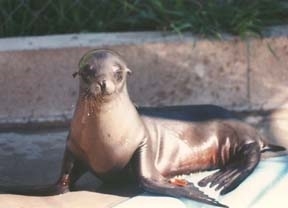 |
What would you do if you were walking along the beach and found a dying animal? When a little girl told California lifeguard Jim Stauffer there was a sick sea lion on the beach, he told her he was very sorry, but there was nothing he could do to help.
"But you save lives, don’t you?" she asked.
Reluctantly, Stauffer followed her down the beach. Thin and weak, the small seal lay on the sand in the need of immediate medical attention. Feeling a sense of responsibility to care for those in need, he loaded the creature into his vehicle and took it to a local veterinarian. The veterinarian provided Stauffer with a crash course in wildlife rescue and care. Over the next few months, Stauffer nursed the pup back to health and released it back to the wild.
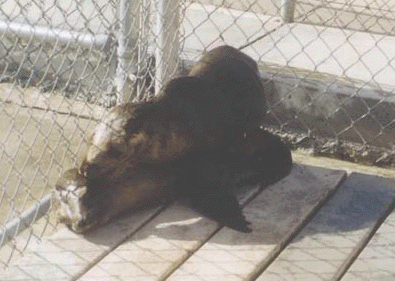 |
| Sea lion pups keep each other company inside a recovery pen. |
The experience would be the beginning of a thirty-year crusade. In 1971, Stauffer founded Friends of the Sea Lion Marine Mammal Center (FSLMMC)(update: now called the Pacific Marine Mammal Center). He ran the organization from his home until 1974, when the city of Laguna Beach gave FSLMMC its own facility, a barn that was originally home to the ASPCA. Stauffer’s friend, John Cunningham, a fellow lifeguard and marine science instructor at Laguna Beach High School, was easily lured into assisting these magnificent creatures. Cunningham and his high school students volunteered their time to convert the barn into a marine mammal care facility. Since then, the organization has rescued, rehabilitated and released to the wild thousands of marine mammals.
Located in Laguna Beach, California, the Center has cared for California sea lions, Pacific harbor seals, northern elephant seals, northern fur seals and various small species of whales and dolphins. The most common species cared for at FSLMMC is the California sea lion.
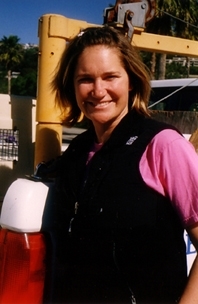 |
| Beaté Litz, Education Director for Friends of the Sea Lion. |
Beaté Litz, Education Director of Friends of the Sea Lion Marine Mammal Center, lists a variety of causes that bring an animal into the Center for treatment.
"Sometimes the problem might be environmental: shark bites, naturally occurring outbreaks of viruses and diseases, or bad storm swells that wash sea lion pups off their nursery sites, called rookeries. Sometimes the problem is caused by people: animals come into the Center with fishing hooks stuck in their skin and mouths, entangled in fishing line and net or, in extreme cases, the animal may have been shot. However, more often we find a malnourished pup that is of a weaned age. Because they are malnourished, they are unable to successfully fight ailments such as respiratory infections or parasites."
During El Niño years, warmer waters in shallow areas force fish into deeper and colder waters causing problems for nursing mothers and their pups. Female sea lions generally leave the rookeries to forage for food and return to the rookeries to nurse their young. When fish are in the deeper water, the mothers must leave for longer periods of time in order to find enough to eat. They must travel further and longer during these times, using up more of their energy. As a result, their milk production decreases and they spend less time nursing their pups. The pups receive fewer feedings with less milk in each feeding and become malnourished.
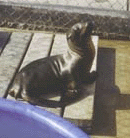 |
| A Center patient basks in the sun by the swimming pool. |
When a marine mammal comes into the Center, volunteers weigh it and take its vital signs. The animals are given names and a symbol is shaved on each animal to help identify it. Fur eventually grows over the symbol. If needed, the animal is then tube-fed a formula, which Litz calls a "fish smoothie." This is fish pureed with water, electrolytes, vitamins and medication. All the animals have comfortable outdoor pens, but during the cold nights, thinner, weaker animals are brought inside, where they sleep under warm lamps. Before release, each animal is tagged with a number so that if it winds up in the Center again, the staff can easily access its medical history.
The pups are, in a word, adorable, but Litz says center workers refrain from touching or talking to them.
"To prevent any type of domestication of these wild animals, we minimize the amount of contact we have with them by not talking to them or touching them. These animals are wild and should be kept that way since they are going to be released back out into the wild. It would be dangerous for them to learn to rely on people. The only time we have direct contact with the animals is when they need to be restrained for wound care or tube feedings," explains Litz.
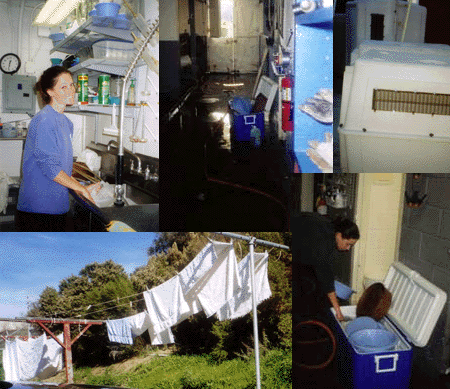 |
| The volunteers' duties include hosing down pens and kennels, washing feeding tubes and syringes, doing laundry, and contributing to the general upkeep of the building. . |
Friends of the Sea Lion Marine Mammal Center relies mostly on volunteers who assist with the daily animal care and education duties around the Center. These duties include hosing down pens, washing feeding tubes and syringes, doing laundry, and contributing to the general upkeep of the building. When there is a dolphin or whale in the facility, volunteers must be there to walk the animal around the pool 24 hours a day to keep it from sinking and drowning.
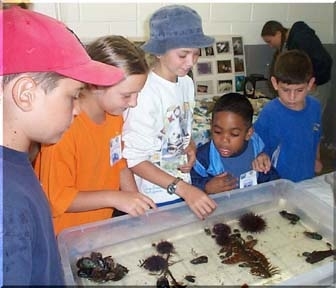 |
| After school kids' club. |
The Center also provides education programs for children and adults. Litz runs a summer day camp and an after school program. Campers participate in mock tube feedings and mock rescues, as well as do thematically related art and craft projects. Center staffers bring a mobile puppet theater to Children’s Hospital and area children’s shelters, and a program currently in development now called Students Excited About Learning (SEAL) will bring school kids from inland districts to participate on the hands-on scientific projects. School field trips allow children to learn about marine mammal care, oceanography, and conservation. Students learn about how Friends of the Sea Lion rehabilitates the animals and get to view the animals in the outdoor pools. For adults, the center offers sponsorship and membership programs. Many adult interest groups visit the facility for the onsite presentation program.
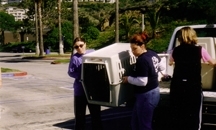 |
| Volunteers preparing to release several sea lions: unloading the cages. |
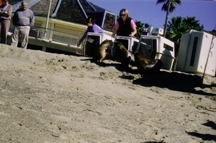 |
| The sea lions are hesitant, at first, to leave the protection of the cages. |
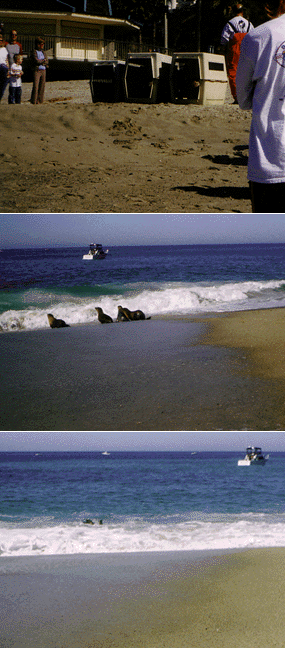 |
| Going home. |
To date, Friends of the Sea Lion Marine Mammal Center has rescued, rehabilitated and released back into their natural habitat thousands of marine mammals.
Page created on 2/3/2009 3:13:59 PM
Last edited 1/5/2017 9:25:04 PM
What's the difference between a sea lion and a seal? | |
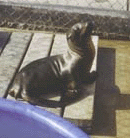 |
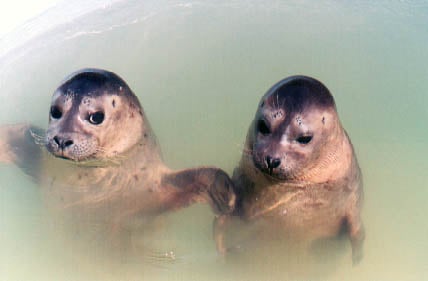 |
California Sea Lion |
Pacific Harbor Seal |
